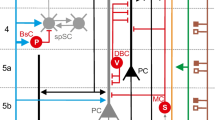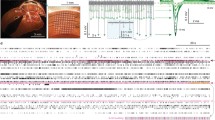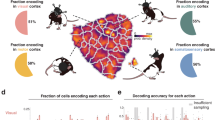Abstract
Studies were carried out in conscious cats with recording of multicellular activity in moderate hunger and after 24-h food deprivation. Cross-correlation analysis was used to assess statistical interneuron interactions between closely-located neurons in the frontal and sensorimotor regions of the neocortex (local networks), and between the cells of these regions (distributed networks). One-day food deprivation increased the number of interactions formed within both local and distributed neuron networks. Increases in intercortical connections between the frontal and motor regions was seen at all time intervals studied (0–100 msec), though the most significant changes occurred at time intervals of up to 30 msec.
Similar content being viewed by others
References
O. S. Adrianov, “The organization of the brain (synopsis of the principle of construction of the functional organization of the brain). Communication II,” Usp. Fiziol. Nauk.,45, No. 2, 335 (1995).
P. V. Bukh-Viner, I. V. Volkov, and G. Kh. Merzhanova, “The spike collector,” Zh. Vyssh. Nerv. Deyat.,40, No. 6, 1194 (1990).
U. G. Gasanov, The System Activity of Cortical Neurons in Learning [in Russian], Nauka, Moscow (1981).
U. G. Gasanov, The Recognition Function of Cortical Neuronal Networks [in Russian], Nauka, Moscow (1992).
É. E. Dolbakyan, G. Kh. Merzhanova, and I. N. Tveritskaya, “Studies of cortical multineuron activity in dogs with a defensive instrumental conditioned reflex,” Zh. Vyssh. Nerv. Deyat.,39, No. 5, 898 (1989).
V. G. Zilov, “The plasticity of dominant motivation,” in: Sixth Anokhin Readings, January 26, 1995 [in Russian], Russian Academy of Medical Sciences Press, Moscow (1995), p. 11.
G. Kh. Merzhanova, “The time organization of interneuronal relationships in the cerebral cortex of the cat in different levels of food motivation,” Zh. Vyssh. Nerv. Deyat.,36, No. 3, 520 (1986).
G. Kh. Merzhanova and A. I. Berg, “A statistical analysis of functional connections between neurons in the visual and motor cortex in different forms of conditioned reflex behavior,” Zh. Vyssh. Nerv. Deyat.,41, No. 2, 291 (1991).
G. Kh. Merzhanova and A. I. Berg, “Frontal-motor interneuron interactions in cats in conditions in cats in conditions of free selections of reinforcement,” Zh. Vyssh. Nerv. Deyat.,44, No. 6, 954 (1994).
I. V. Pavlova, I. V. Volkov, and V. N. Mats, “The effect of stimulation of the medial hypothalamus on neuron interactions in the rabbit neocortex,” Zh. Vyssh. Nerv. Deyat.,45, No. 2, 335 (1995).
K. V. Sudakov and B. V. Zhuravlev, “The train-like rhythms of neurons as a reflection of processes of waiting for food reinforcement in hungry animals,” Zh. Vyssh. Nerv. Deyat.29, No. 3, 643 (1979).
K. V. Sudakov, Neuronal Mechanisms of the Organization of the System “Quantum” of Behavior. Neurons in Behavior. System Aspects [in Russian], Nauka, Moscow (1986), p. 58.
N. O. Timofeeva, I. I. Semikopnaya, and T. V. Salikova “A neurophysiological analysis of the determining role of motivation in the organization of behavior,” in: Comparative Physiology of Higher Nervous Activity in Humans and Animals [in Russian], Nauka, Moscow (1990), p. 138.
Yu. A. Fadeev, “The spike activity of cortical neurons during the formation and production of purposive behavior,” Usp. Fiziol. Nauk.,11, No. 3, 12 (1980).
V. V. Shabaev, “Conditions of change in interval-selective functional connections between neurons in the CNS,” in: Conditioned Reflexes in the System of Neurosciences [in Russian], Proceedings of All-Union Symposium, Nauka, Leningrad (1991), p. 132.
M. H. Y. Aersten and G. L. Gerstein, “Evaluation of neuronal connectivity: sensitivity of cross-correlation,” Brain Res.,340, No. 2, 341 (1985).
A. K. Engel, P. Konig, A. K. Kleiter, et al., “Temporal coding in the visual cortex: new vistas on integration in the nervous system,” TINS,15, No. 6, 218 (1992).
K. Graham and J. Duffin, “Cross-correlation of medullary expiratory neurons in the cat,” Expt. Neurol.,73, No. 2, 451 (1981).
G. P. Moore, J. P. Segundo, D. J. Perkel, and H. Levitan, “Statistical signs of synaptic interaction in neurons,” Biophys. J.,10, 876 (1970).
F. Reinoso-Suarez, Topographischer Hirnaatlas der Katze (Für Experimental-Physiologische Untersuchungen, Darmstadt (1961).
M. N. Shadlen and W. T. Newsome, “Noise, neural codes and cortical organization,” Curr. Opinion in Neurobiol.,4, 569 (1994).
H. Vanegas, W. E. Foote, W. E. Flynn, and J. P. Flin, “Hypothalamic influences upon activity of units of the visual cortex,” Yell. J. Biol. and Med.,45, No. 1, 191 (1970).
Additional information
Institute of Higher Nervous Activity and Neurophysiology. Russian Academy of Sciences, Moscow. Translated from Zhurnal Vysshei Nervnoi Deyatel'nosti, Vol. 46, No. 3, pp. 513–520, May–June, 1996.
Rights and permissions
About this article
Cite this article
Merzhanova, G.K., Dolbakyan, É.E. Time organization of frontal-motor cortex interneuron interactions in the cat neocortex in conditions of different levels of food motivation. Neurosci Behav Physiol 27, 360–366 (1997). https://doi.org/10.1007/BF02462936
Received:
Accepted:
Issue Date:
DOI: https://doi.org/10.1007/BF02462936




